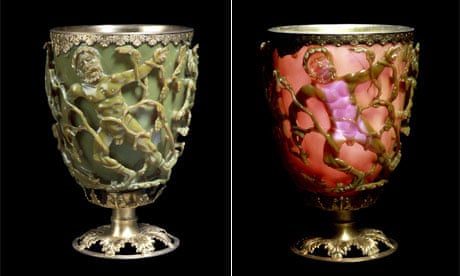The ancient empires of the world are remembered for their impressive large-scale feats of engineering: Macchu Picchu in Peru; the pyramids in Egypt; and the Parthenon in Greece to name a few. But the craftsmen of those eras were also skilled at engineering at the opposite end of the spectrum at the nanoscale.
The manipulation of material at the atomic and molecular scale to create new functions and properties sounds like it should be a profoundly modern concept. But artisans from the past also controlled matter at the tiniest scales. By modern-day standards, they were working in a branch of nanotechnology called nanocomposites. These are bulk materials in which nanoscale particles are mixed to improve the properties of the overall or composite material.
There are a number of relatively famous examples of ancient artefacts which were created using nanocomposites. The Lycurgus cup, for example, is a stunning decorative Roman treasure from about AD400; it is made of a glass that changes colour when light is shone through it. The glass contains gold-silver alloyed nanoparticles, which are distributed in such a way to make the glass look green in reflected light but, when light passes through the cup, it reveals a brilliant red.
A corrosion resistant azure pigment known as Maya Blue, first produced in AD800, was discovered in the pre-columbian Mayan city of Chichen Itza. It is complex material containing clay with nanopores into which indigo dye was combined chemically to create an environmentally-stable pigment.
Damascus steel swords from the Middle East were made between AD300 and AD1700 and are known for their impressive strength, shatter resistance and exceptionally sharp cutting edge. The steel blades contain oriented nanoscale wire-and-tube-like structures, which almost certainly enhanced the material's properties.
Pottery from across the Renaissance Mediterranean world was often decorated with an iridescent metallic glaze called lustre, the colour and sheen of which is a down to nanoparticles of copper or silver.
So can we call the craftsmen who made these materials nanotechnologists? Ian Freestone at the Institute of Archaeology at University College London, who studied the Lycurgus cup, thinks not. "They were highly skilled but they were not nanotechnologists. They did not know that they were working on the nanoscale," he says.
Peter Paufler from TU Dresden, who led the research on the Damascus sword agrees. "They developed materials by trial and error similar to evolution in biology. They didn't know the processes going on inside the solids."
High-resolution microscopic analysis is used to reveal the nanostructure of these artefacts, but such analysis cannot tell us how they were made. "How did they dissolve these metals into the glass?" says Freestone of the Roman glassmakers who made the Lycurgus cup. "And how did they get such a homogenous distribution of nanoparticles? We can speculate but we really don't know for sure."
However, historical texts from Spain, Italy and the Middle East have revealed how lustreware was made, offering a new procedure for generating metal-glass nanocomposites.
A disadvantage of using high-resolution microscopy is that samples must be milled down to a fraction of their original thickness, destroying part of the artefact. When the material is abundant, such as for weather-resistant Maya Blue, taking a little for analysis is not a big deal. But when these artefacts are rare, it's more difficult to justify. "There's no way it would have been acceptable to remove a sample of the Lycurgus cup," says Freestone. "It's too unique, too valuable. Fortunately for us, some fragments of the glass were found in its metal base several decades ago and were saved."
In the case of the steel sword, the curators at the Historical Museum Berne, which donated the sword, weighed up the potential benefits against the loss of one of their collection pieces. "Workers obviously felt that sufficient original blades were available to sacrifice some for research," says Paufler.
Such sacrifices are worth it. Some of these studies are providing pointers for new nanotechnology research. Understanding the nanoscale mechanism underlying how Maya Blue works has generated a new direction for scientists to investigate stable hybrid nanostructured pigments. Researchers from the French National Centre for Scientific Research have investigated a variety of nanoporous materials in which to insert and stabilise organic dyes.
Researchers from the University of Turin have also investigated the potential of the Maya Blue method for generating environmental-resistant pigments from different coloured dyes.
Similarly, understanding the properties of the Lycurgus cup has led to new nanocomposites with potentially useful optical properties. For example, researchers have developed thin nanocomposite films containing gold nanoparticles which can reflect infra-red while still transmitting light. Ivan Parkin, from UCL, who took part in the research, says: "We effectively tried to replicate the effect seen in the Lycurgus cup to recreate the extraordinary coloration efficiency that the Romans achieved." These films could be used to coat windows in hot countries to reflect heat away while allow light through the glass, thus reducing the need for air conditioning.
These historic structures are the results of hundreds of years of trial and error experimentation with craftsmen passing their skills and know-how down through generations. Nanotechnologists can also now build on this ancient wisdom. But they benefit from a modern understanding of the behaviour of atoms and molecules along with state-of-the-art fabrication tools and analytical instruments to achieve exciting new products and devices in a fraction of the time.

Comments (…)
Sign in or create your Guardian account to join the discussion